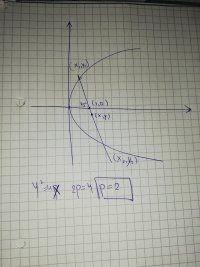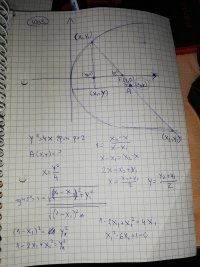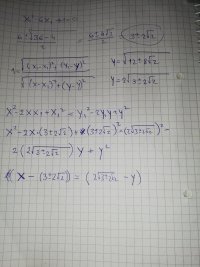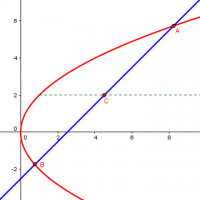You are using an out of date browser. It may not display this or other websites correctly.
You should upgrade or use an alternative browser.
You should upgrade or use an alternative browser.
Geometric locus
- Thread starter Loki123
- Start date
Harry_the_cat
Elite Member
- Joined
- Mar 16, 2016
- Messages
- 3,693
A chord of the parabola y^2 = 4x, which coincides with the Ox axis 45 degrees, would slope upwards to the right with a gradient of 1. Your chord is sloping downwards. The angle is measured anticlockwise from the positive x direction.
The equation of such lines would be y = x + c.
I can't really follow what you are doing or why you seem to be using the distance formula.
To investigate what is going on with the midpoint, you could try looking at y=x+1, then y=x+2, etc. Find the points of intersection and then the midpoint.
Or, if you are more confident, you could get straight into the general case using y= x + c.
The equation of such lines would be y = x + c.
I can't really follow what you are doing or why you seem to be using the distance formula.
To investigate what is going on with the midpoint, you could try looking at y=x+1, then y=x+2, etc. Find the points of intersection and then the midpoint.
Or, if you are more confident, you could get straight into the general case using y= x + c.
I get that the angle should be the other way around but I don't get how to find intercept points. Like why do I replace c with 1,2,3... When the line would be cutting into the negative part of the y line. Shouldn't I use - 1,-2,-3.. For c? And where do I stop with those valuesA chord of the parabola y^2 = 4x, which coincides with the Ox axis 45 degrees, would slope upwards to the right with a gradient of 1. Your chord is sloping downwards. The angle is measured anticlockwise from the positive x direction.
The equation of such lines would be y = x + c.
I can't really follow what you are doing or why you seem to be using the distance formula.
To investigate what is going on with the midpoint, you could try looking at y=x+1, then y=x+2, etc. Find the points of intersection and then the midpoint.
Or, if you are more confident, you could get straight into the general case using y= x + c.
Harry_the_cat
Elite Member
- Joined
- Mar 16, 2016
- Messages
- 3,693
Yeah ok. Look at y=x-1 first. This will just help you see what is going on.
Find the pts of intersection of the line y=x-1 and the parabola y^2=4x. Solve simultaneously to find pts of intersection.
Find the pts of intersection of the line y=x-1 and the parabola y^2=4x. Solve simultaneously to find pts of intersection.
Yeah i dont get it. How about using y=kx + c directlyYeah ok. Look at y=x-1 first. This will just help you see what is going on.
Find the pts of intersection of the line y=x-1 and the parabola y^2=4x. Solve simultaneously to find pts of intersection.
Dr.Peterson
Elite Member
- Joined
- Nov 12, 2017
- Messages
- 16,091
I think where you wrote "coincides" you should have "meets" or "intersects". And they are not talking about just one particular chord, but any chord at that angle. So we want to describe where the midpoints of all chords at a 45 degree angle are located.Determine the geometric locus of the middle of the chord of the parabola y ^ 2 = 4x, which coincides with the Ox axis at an angle of 45 degrees.
My idea was to use tan and to put the chord through F point. I attached that work, but It's probably useless.
Consider any line with a slope of 1, say y = x - c. (You could use slope -1; the problem doesn't say, but they probably intend a positive slope.) This line will intersect the x-axis at x = c, which can be anywhere.
Find the intersections of this line with the curve y^2 = 4x, by solving the system of equations, keeping c as a parameter. You will get x and y in terms of c. If necessary, then eliminate c to get an equation involving only x and y.
You may be surprised at some point and think something went wrong, when in fact you have just finished early ...
How do I eliminate c? Or in my case n...I think where you wrote "coincides" you should have "meets" or "intersects". And they are not talking about just one particular chord, but any chord at that angle. So we want to describe where the midpoints of all chords at a 45 degree angle are located.
Consider any line with a slope of 1, say y = x - c. (You could use slope -1; the problem doesn't say, but they probably intend a positive slope.) This line will intersect the x-axis at x = c, which can be anywhere.
Find the intersections of this line with the curve y^2 = 4x, by solving the system of equations, keeping c as a parameter. You will get x and y in terms of c. If necessary, then eliminate c to get an equation involving only x and y.
You may be surprised at some point and think something went wrong, when in fact you have just finished early ...
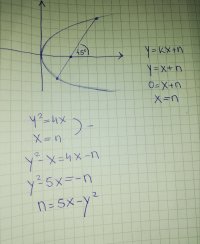
Dr.Peterson
Elite Member
- Joined
- Nov 12, 2017
- Messages
- 16,091
You used the line y = kx + n, with k = 1, and found its x-intercept. Why? That is not involved in the problem at all. There is something you are misunderstanding.
The equation x = n is a vertical line. And the work you did isn't even correct to find the intersections with that line. (Do you have enough experience solving [non-linear] systems of equations?)
Start again: You want to find the intersections of y^2 = 4x and y = x + n. You can either replace y with x + n in the first equation, or replace x with y - n in the first equation. Then you will have an equation in one variable (and the parameter n), and can solve (using the quadratic formula).
Then you'll want to find the midpoint between the two intersections you find.
The equation x = n is a vertical line. And the work you did isn't even correct to find the intersections with that line. (Do you have enough experience solving [non-linear] systems of equations?)
Start again: You want to find the intersections of y^2 = 4x and y = x + n. You can either replace y with x + n in the first equation, or replace x with y - n in the first equation. Then you will have an equation in one variable (and the parameter n), and can solve (using the quadratic formula).
Then you'll want to find the midpoint between the two intersections you find.
I thought I should find the x-intercept because of this.This line will intersect the x-axis at x = c, which can be anywhere.
Dr.Peterson
Elite Member
- Joined
- Nov 12, 2017
- Messages
- 16,091
No, was just telling you what the x-intercept was, because you had initially put it at (1,0), and I wanted to emphasize that it varies. There is no reason to use it for anything.I thought I should find the x-intercept because of this.
Have you made any progress?
You are given the red curve, and want to find the locus of C, the middle of any chord AB at a 45 degree slope:
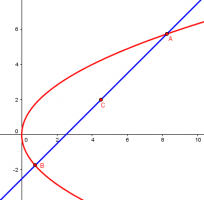
Find A and B first. Where are they?
Maybe this?
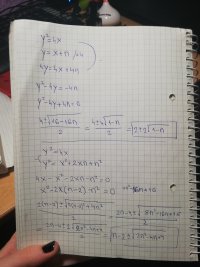

No, was just telling you what the x-intercept was, because you had initially put it at (1,0), and I wanted to emphasize that it varies. There is no reason to use it for anything.
Have you made any progress?
You are given the red curve, and want to find the locus of C, the middle of any chord AB at a 45 degree slope:
View attachment 31400
Find A and B first. Where are they?
Dr.Peterson
Elite Member
- Joined
- Nov 12, 2017
- Messages
- 16,091
You're getting there. Good work on finding y (though you forgot to say that what you found was y!).Maybe this?
View attachment 31405
There's a sign error in your work for x. But also, you could have found x more easily after finding y, using the fact that x = y - n.
Now, find the midpoint. That will be easy, because of those [imath]\pm[/imath] symbols!
Harry_the_cat
Elite Member
- Joined
- Mar 16, 2016
- Messages
- 3,693
Check you third bottom line. Should be -x^2
Harry_the_cat
Elite Member
- Joined
- Mar 16, 2016
- Messages
- 3,693
k=1, so you want to consider y=x+c. Yes. I wasn't sure if you could handle the algebra but your last few posts show that you can.Yeah i dont get it. How about using y=kx + c directly
I suggested looking at a few specific values of c just to get you to see what is happening, as the algebra is easier without the parameter c floating around.
Then, you could move on to the general case with the parameter c.
But continue with what you are doing. You are nearly there.
y=2 is the correct answer. Why can I dismiss what I got for x?You're getting there. Good work on finding y (though you forgot to say that what you found was y!).
There's a sign error in your work for x. But also, you could have found x more easily after finding y, using the fact that x = y - n.
Now, find the midpoint. That will be easy, because of those [imath]\pm[/imath] symbols!
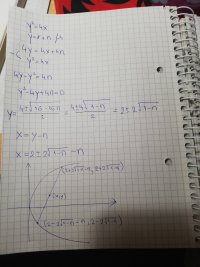
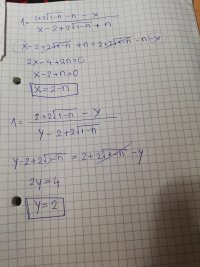
Dr.Peterson
Elite Member
- Joined
- Nov 12, 2017
- Messages
- 16,091
This is where I said, "You may be surprised at some point and think something went wrong, when in fact you have just finished early ...".y=2 is the correct answer. Why can I dismiss what I got for x?
View attachment 31408
View attachment 31409
You expressed x and y in terms of n, and normally the next thing would be to eliminate the parameter, n, because your final answer must be an equation in just x and y. But you've found that one of the equations, for y, is already independent of n, so that is the answer. The equation for x just tells you, in effect, that x can have any value, independent of y! That tells you nothing about the locus itself, only something about a specific point on it.
I'm not sure what you're doing with the big fractions. What I would have done is to find the midpoint as the average of the endpoints, so x is the sum of the two x-coordinates, which lets the radicals cancel out, divided by 2, and you are left with x = 2 - n; and y is found the same way, leaving only y = 2.
Here is a graph of the problem, in which I told GeoGebra to show me the locus of C:
One thing this reveals is that the answer isn't really the entire line y = 2, but just the part to the right of the parabola, because to the left, there is no chord! It takes a little more insight to realize that algebraically.
Got it! Thanks! As for my way of finding midpoints, it's basically (x1-x)This is where I said, "You may be surprised at some point and think something went wrong, when in fact you have just finished early ...".
You expressed x and y in terms of n, and normally the next thing would be to eliminate the parameter, n, because your final answer must be an equation in just x and y. But you've found that one of the equations, for y, is already independent of n, so that is the answer. The equation for x just tells you, in effect, that x can have any value, independent of y! That tells you nothing about the locus itself, only something about a specific point on it.
I'm not sure what you're doing with the big fractions. What I would have done is to find the midpoint as the average of the endpoints, so x is the sum of the two x-coordinates, which lets the radicals cancel out, divided by 2, and you are left with x = 2 - n; and y is found the same way, leaving only y = 2.
Here is a graph of the problem, in which I told GeoGebra to show me the locus of C:
One thing this reveals is that the answer isn't really the entire line y = 2, but just the part to the right of the parabola, because to the left, there is no chord! It takes a little more insight to realize that algebraically.

